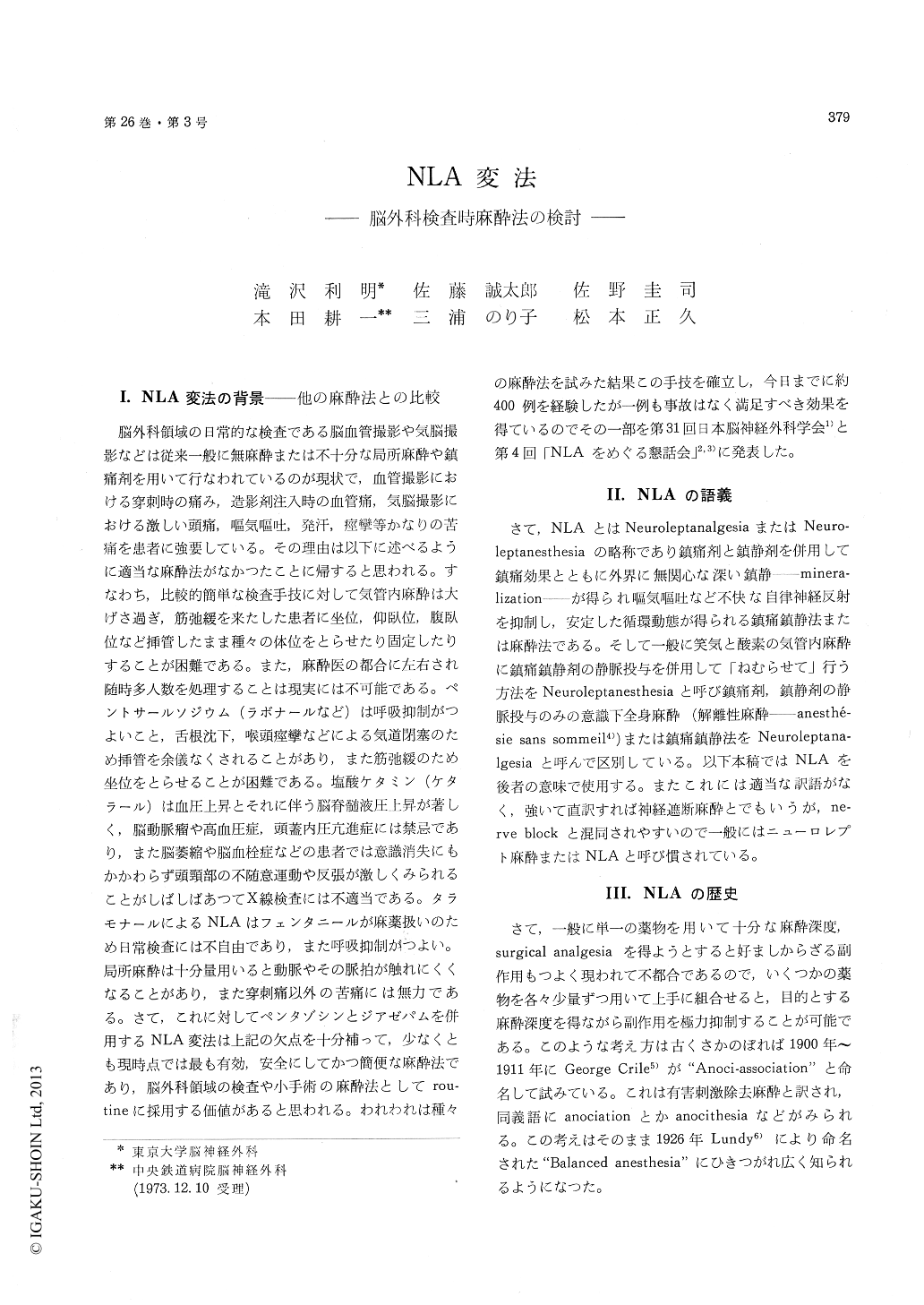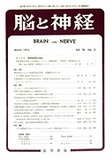Japanese
English
- 有料閲覧
- Abstract 文献概要
- 1ページ目 Look Inside
I.NLA変法の背景--他の麻酔法との比較
脳外科領域の日常的な検査である脳血管撮影や気脳撮影などは従来一般に無麻酔または不十分な局所麻酔や鎮痛剤を用いて行なわれているのが現状で,血管撮影における穿刺時の痛み,造影剤注入時の血管痛,気脳撮影における激しい頭痛,嘔気嘔吐,発汗,痙攣等かなりの苦痛を患者に強要している。その理由は以下に述べるように適当な麻酔法がなかつたことに帰すると思われる。すなわち,比較的簡単な検査手技に対して気管内麻酔は大げさ過ぎ,筋弛緩を来たした患者に坐位,仰臥位,腹臥位など挿管したまま種々の体位をとらせたり固定したりすることが困難である。また,麻酔医の都合に左右され随時多人数を処理することは現実には不可能である。ペントサールソジウム(ラボナールなど)は呼吸抑制がつよいこと,舌根沈下,喉頭痙攣などによる気道閉塞のため挿管を余儀なくされることがあり,また筋弛緩のため坐位をとらせることが困難である。塩酸ケタミン(ケタラール)は血圧上昇とそれに伴う脳脊髄液圧上昇が著しく,脳動脈瘤や高血圧症,頭蓋内圧亢進症には禁忌であり,また脳萎縮や脳血栓症などの患者では意識消失にもかかわらず頭頸部の不随意運動や反張が激しくみられることがしばしばあつてX線検査には不適当である。タラモナールによるNLAはフェンタニールが麻薬扱いのため日常検査には不自由であり,また呼吸抑制がつよい。局所麻酔は十分量用いると動脈やその脈拍が触れにくくなることがあり,また穿刺痛以外の苦痛には無力である。さて,これに対してペンタゾシンとジァゼパムを併用するNLA変法は上記の欠点を十分補って,少なくとも現時点では最も有効,安全にしてかつ簡便な麻酔法であり,脳外科領域の検査や小手術の麻酔法としてrou—tineに採用する価値があると思われる。われわれは種々の麻酔法を試みた結果この手技を確立し,今日までに約400例を経験したが一例も事故はなく満足すべき効果を得ているのでその一部を第31回日本脳神経外科学会1)と第4回「NLAをめぐる懇話会」2,3)に発表した。
We have applied Modified Neuroleptanalgesiawith Pentazocine and Diazepam to such painfulneurosurgical examinations as airstudy, cerebralangiography, etc. More than 400 cases includingthe minor operations were treated with satisfactoryanalgesia, sedation and prevention of vomiting andsweating in every case.
Circulatory stability and the minimal suppresionof the respiration are also the common merits ofthis method. As the verbal contact was preserved,the patients were able to keep themselves in sit-ting position during the airstudy. They remainedtranquil and cooperative during the examinations.None of them complained of headache nor nausea.
No choke, convulsion, vomiting or sweating wasnoticed. And what is more, some of the patients had a good appetite even after pneumoencephlo-graphy. Usually, no further analgesia or sedationwas needed after the examinations. Amnesia dur-ing the examination was noticed in most of the cases, but it was considered to be one of the con-venient merits, for they would not have any fearof the successive examinations.
Method:
Premedication:0. 5 mg of atropine sulfate and10 mg of diazepam i. m.
Several minutes before operation or examination : 30 to 60 mg (45 mg on an average) of pentazocine and 10 mg of diazepam i. v.
* Diazepam should not mixed with pentazocine because of the turbid change. It is con- venient to inject them through the i. v. drip catheter respectively.
* Transitory suppresion of the respiration might occur by rapid injection of pentazocine in some cases of poor risk. In such case, intravenous injection of Theraptique is very effective.
In further 12 cases, blood pressure, cerebrospinal fluid pressure and central venous pressure were recorded continuously through the transducers on the polygraph. In 5 cases of them, Pao? Paco? pH and BE were examined.
Result :
1. Blood pressure was very stable in every case.
2. 130 mmH2O of mean increase in CSF pressure at the maximum change.
3. 20 mmH20 of mean increase in CVP at the maximum change.
4. 6 mmHg of mean increase in Paco2.
5. 15 mmHg of mean decrease in Paco2.
6. Slight shift of pH to acidosis.
7. Small change in BE.
8. Pinprick and carotid puncture were performed on the way, but no change in these parameters was noticed. Therefore, the effect of the analgesia was considered to be complete both subjectively and objectively.
9. The increase in CSF pressure was considered to be due to the increase in Pace, and it was easily reduced by inhalation of oxygen gas.
Modified Neuroleptanalgesia is recommended as a routine anesthesia for the painful neurosurgical examinations and the minor operations, because it is considered to be up-to-date the most effective,safe and simple anesthesia. But, it is not an adequet anesthesia for craniotomy.
In this paper, the history and the pharmacological basis of the Modified Neuroleptanalgesia were also explained in addition to the description of the clinical experiments.

Copyright © 1974, Igaku-Shoin Ltd. All rights reserved.


